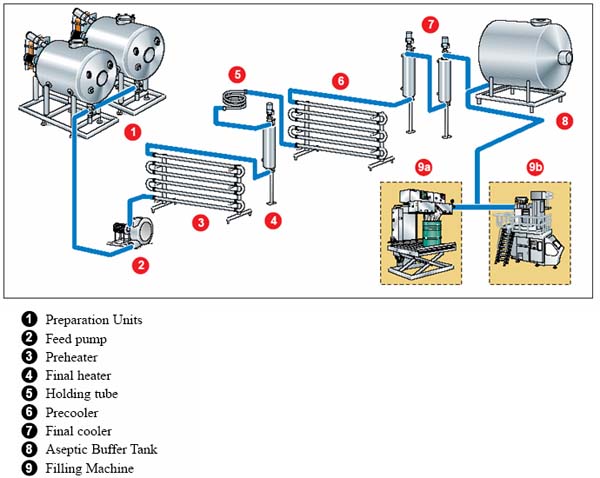Desert sauces
Back to Information about fruits & vegetables
I. GENERAL DESCRIPTION:
- 1. General Flowsheet of marmelade pasteurization
Figure 1: Marmelade pasteurization.
- 2. Description of techniques, methods and equipment
- (BAT for Food, Drink and Milk Industries, June 2005)
Preserving is the manufacture of jams, jellies, marmalades and mincemeat. It is essentially the combining of fruits and sugar with subsequent cooking. It produces a tasty product of a sufficiently high sugar content, low aw value, and with a satisfactory shelf-life retention quality. In the belt blanching process with air cooling of desert sauces, cooling of the food to about 40°C is sufficient, because it is subject to further processing involving heat which prevents the development of bacteriological problems. Preserves undergo heat treatment at a later stage, e.g. during sterilization and pasteurization. This means that less energy is used when applying this technique for deserve sauces, comparing to other uses of the fruit and vegetables sector which would need to be cooled further, e.g. prior to freezing. A pasteurizing treatment is applied at 85°C or above. The jams are made using pulp and fruit juice, e.g. citrus for marmalade, and clarified juice for jellies. In a typical process, the fruit usually arrives pre-prepared either frozen or sulphited. The prepared fruit and the other ingredients are blended together in a mixing vessel. The mix is boiled either at atmospheric pressure or under vacuum, using batch or continuous methods. After boiling, the jam is filled into containers which vary from individual portions to bulk tank for bakery use.
- 3. Temperature ranges and other parameters (table)
- (BAT for Food, Drink and Milk Industries, June 2005)
- 4. Benchmark data
No information is available.
II. NEW TECHNOLOGIES:
- a) Changes in the process
No information is available.
- b) Changes in the energy distribution system
No information is available.
- c) Changes in the heat supply system
No information is available.
III. SOLAR SYSTEMS INTEGRATION:
No information is available.

